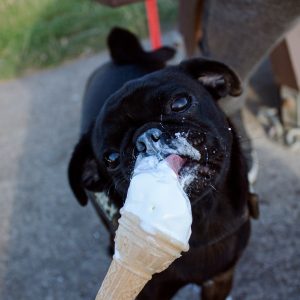4 Behavior Modification Techniques and What Works Best for Your Pug
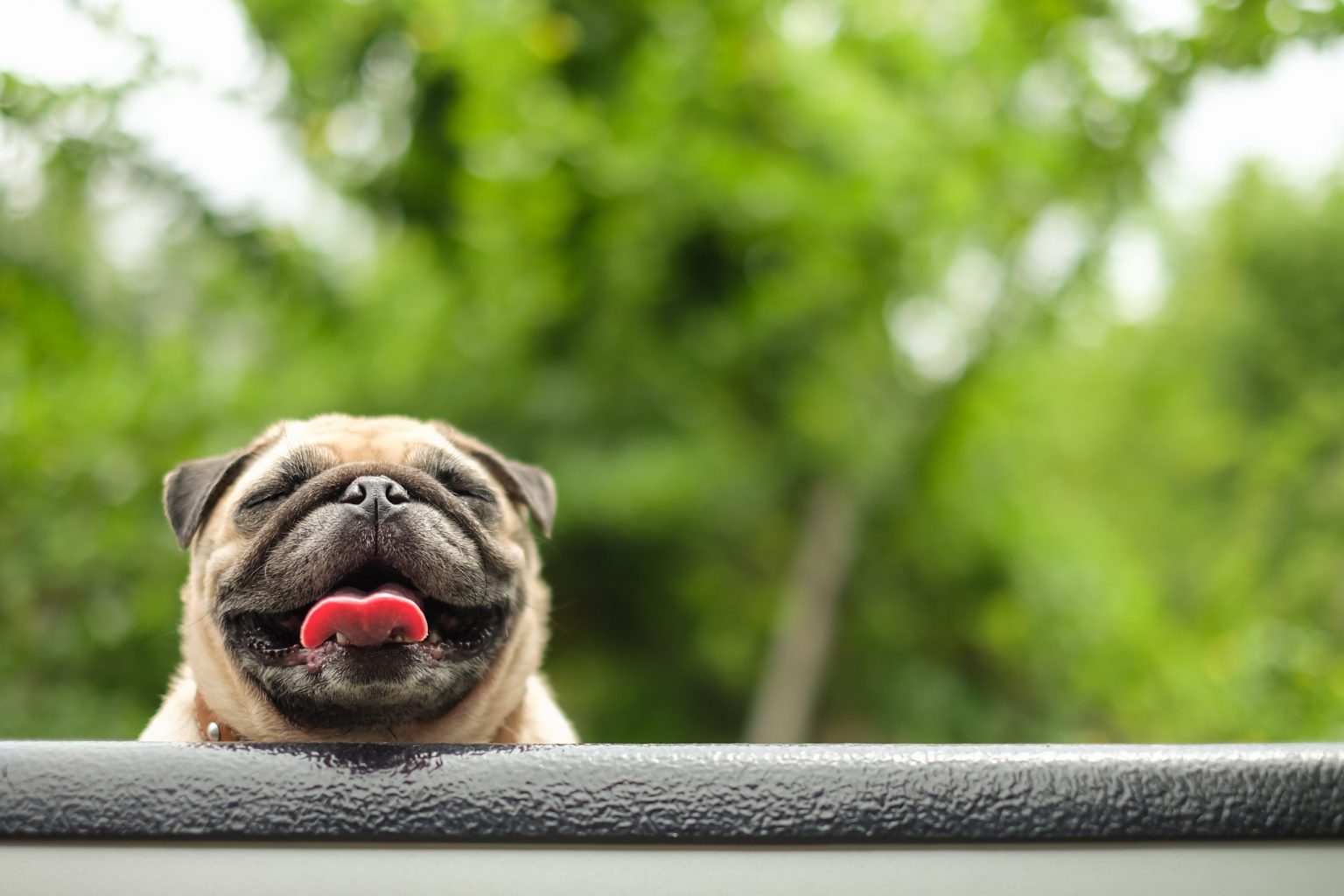
Congrats on deciding to train your Pug dog. Maybe you’ve heard that Pugs are difficult to train or you’ve tried in the past and failed.
Learn all about behavior modification and get great results in your Pug training. Plus, you and your Pug will love it.
When you train your Pug, you either want to increase or decrease our Pug’s behavior. We do this by giving him something or taking something away.
Four Definitions You Need to Know About Behavior Modification Before Beginning to Train Your Pug
- Reinforcers are anything that increases specific behavior.
- Punishments are anything that decreases behavior.
- Positive means to add or give something.
- Negative means to subtract or take something away.
People have been using behavior modification for dogs since domestication started. Like most things in life, people can use it for good or harm.
Four Types of Pug Training Using Behavior Modification
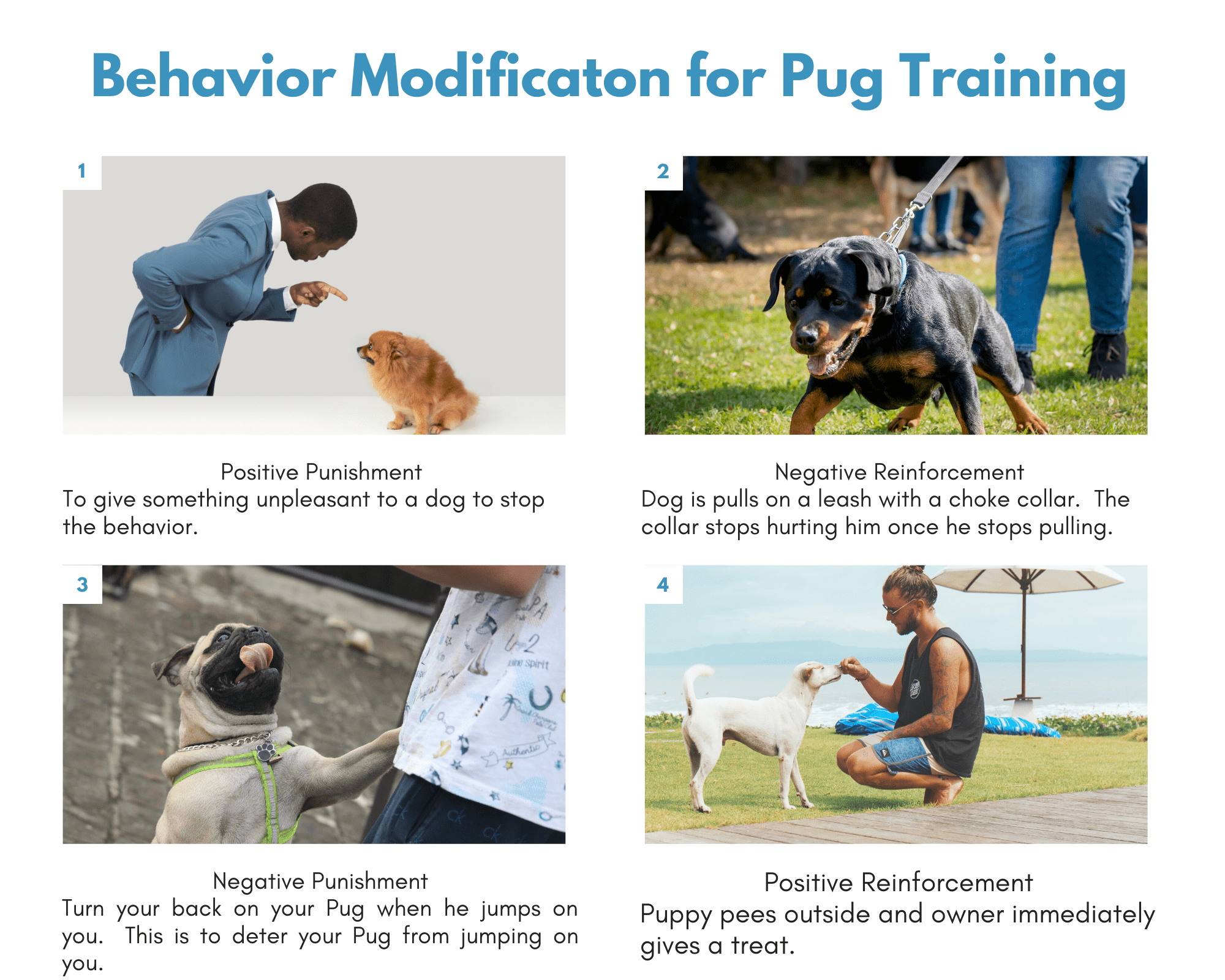
Number 1. Train your Pug Using Positive Punishment
Positive punishment means doing something unpleasant to stop or decrease the dog’s behavior. The theory is that if this occurs enough times, the dog will stop doing it in the future.
Here are some examples:
- Spanking your dog after he pees on the floor.
- Tapping his nose when your puppy nips at you.
- Yelling at your dog to get off the furniture.
- Using a citronella collar to spray citronella when your dog barks.
- Holding your dog down in a dominant position until he calms down.
Does Positive Punishment Work?
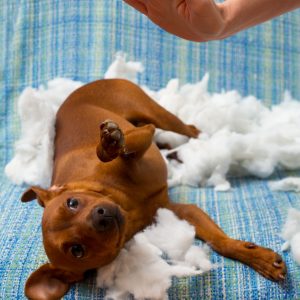 If you hurt your Pug dog, he will either become afraid, anxious and/or aggressive toward you. Let’s say you tap your Pug on the nose because he’s putting his nose in your pizza. A tap on the nose probably does not hurt your Pug. But it scares him. We’ve all seen dogs who are shy around people’s hands.
If you hurt your Pug dog, he will either become afraid, anxious and/or aggressive toward you. Let’s say you tap your Pug on the nose because he’s putting his nose in your pizza. A tap on the nose probably does not hurt your Pug. But it scares him. We’ve all seen dogs who are shy around people’s hands.
What do you think happens the next time Friday night pizza comes around? Is he going to remember getting tapped on the nose and not try to swipe that piece of pizza again?
The answer is no. The smell and sight of that pizza are too rewarding. All he can think about is getting a bite of that pizza.
You want to train your Pug, not hurt or scare your Pug.
Yelling Doesn’t Work
When the UPS or FEDEX person pulls up in my driveway, my Pugs fly to the front window and start barking. If I yell at them every time this happens, you would assume that the barking would stop. After all, I’m consistent. Nope. It doesn’t work.
My yelling adds to the frenzy of the whole thing. My Pugs are barking, and I’m yelling. Maybe they’re thinking. “Wow! This is a bad situation, even she’s yelling.” And the barking ALWAYS pays off for the Pugs.
That delivery person always leaves and never breaks into their territory.
If you’re upset with your Pug dog, and he realizes this, this could add to his confusion. Is she yelling because I’m standing up and looking out the window? Is it my tail wagging, is it my barking? Pugs can’t read minds.
Teaching Your Pug Dog to Pooh out of Sight
Let’s say your dog goes pooh in the house. You yell and put her outside. Have you ever noticed that dogs learn very to pooh in the closet or somewhere you can’t see the pooh? It’s because when you yelled and Put her outside, what you taught her was to not pooh in front of you. She’s not sneaky, get one over on you, or any other negative quality people sometimes think. You taught her to go to a different room to pooh. That’s one way to train your Pug.
The Risks of Using Positive Punishment
Using positive punishment can create fear, stress, and aggression. Often dogs will become more aggressive because they are afraid of you. You’ve become this unpredictable person who hurts you.
They will be more vigilant about watching for cues that you are going to hurt him again. Causing harm makes them very cautious. You may think they are getting more aggressive. He may be trying to protect himself even more so now that you have become aggressive. This is not a good way to train your Pug.
P.J. the Flying Ninja
Sadly, I must admit when I was a kid; I would roll up a newspaper and swat our family dog on the rump when he would misbehave. When he would see me roll up that newspaper, he would transform himself into a flying ninja. Across the room, he would fly at me, bite and tear-up the newspaper.
So, between my parents and my dog, I learned to stop rolling up the damn newspaper and swatting him on the butt.
The flying ninja dog once again became our sweet family dog.
Number 2. Train your Pug Using Negative Punishment
How Parents Use Negative Reinforcement
Negative punishment is when you subtract or take something away to make the behavior stop.
Let’s say a child misbehaves. For example, maybe he pushes his brother. The parent sees what happens and takes the toy away.
 Parents take things away all the time with teenagers. If their grades drop, they take the cell phone away. “When you get back to all A’s and B’s, you get your cell phone back.”
Parents take things away all the time with teenagers. If their grades drop, they take the cell phone away. “When you get back to all A’s and B’s, you get your cell phone back.”
If this is going to work at all, the reaction must be immediate. A child has poor grades, and the parents don’t get the report a week later. Then they take the cell phone away.
Most likely, it won’t work. Their child will say things like, “But I’ve been doing good for the past week. That’s not fair!”
And you better do it consistently every time. The child says, “You know that teacher has it out for me.” The parent gives in with, “You’re right. All your other grades are good. Here’s your cell phone back.”t’s not fair!”
If the parent does take the cell phone away, he or she needs to tell the teenager what they need to do to get their grades up.
This does not mean “Get your grades up or you’ll never get your phone back.” It has to be specific. The teenager needs to know they have to seek out a tutor or talk to the teacher for a better understanding of the work. She needs to apply effort when doing his homework, not just sit in his room thinking about how unfair his parents are.
How Pug Parents Use Negative Reinforcement
Your Pug puppy is jumping on you when you get home from work. You turn your back on your Pug, withdrawing your attention. The idea is that he will be less likely to jump on you in the future. You’ve decided this is a good way to train your Pug.
You’ve been practicing turning your back on your Pug and not giving him any attention when he jumps on you.
One day you come home, and you’re in a great mood. You forget all about turning your back on him. You’re happy.
You see, you’re happy little Pug puppy and bend down, giving lots of attention and getting kisses.
Uh-oh. He has seen that you may give in. His jumping may increase for a while.
Does Negative Punishment Work?
Negative punishment can work if used correctly, consistently and immediately. This is a pretty tall order. Consistently means you train your Pug this way all the time, not just during Pug training sessions.
Adding Positive Reinforcement to the Negative Punishment
There’s another more effective way to train your Pug. You can pair negative punishment with positive reinforcement.
Your Pug dog jumps on you, you move away, and you turn your back on him. He may figure out eventually that you don’t want him to jump on you. We know our Pugs are the smartest of them all! But, this may take him a while to figure out what is going on.
If you want to train your Pug dog to learn faster, turn your back when he jumps and turn back around when he stops. Then ask him to sit. This gives him more information on what you would like for him. When he politely sits, reinforce him positively with praise and attention.
This is not a one-time event. It may take weeks to get them to stop jumping and sit instead, but in the end, it will be worth it. Do you want your Pug dog to jump all over you for the rest of your life? Or do you want a few weeks of hard work, followed by some excellent Pug politeness behavior?
It’s a win-win. You don’t get jumped on, and he gets the positive attention he so desires. That’s what all the jumping on you was about anyhow. It’s a great way to train your Pug.
Number 3. Train your Pug Using Positive Reinforcers
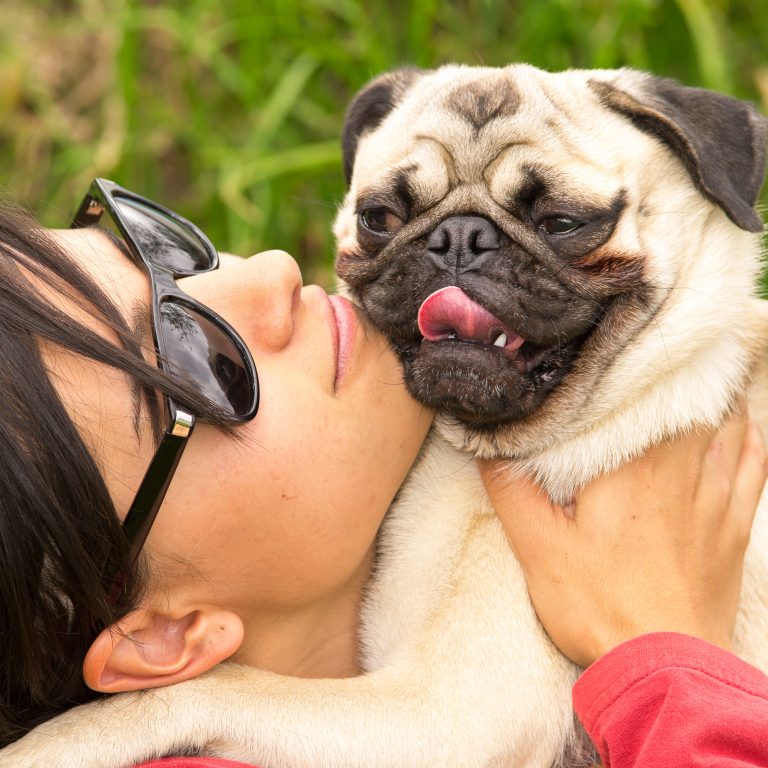
Positive reinforcers are when something good comes after a particular behavior. For example, if your child gets an A on her math, you take her out for ice cream that evening. Praising your child is another form of positive reinforcement.
When your puppy goes pee outside, you praise her and give her a treat. She wants the food and praise, so eventually, she will learn to pee outside. Using treats is a good way to train your Pug to do her business outside.
Does Positive Reinforcement Work?
Yes. Praising and giving treats to your Pug dog helps them learn quickly. It’s a great way to train your Pug. Once my Pugs learned they received a treat for sitting, they started sitting on their own when I was there. They see me go into the pantry where their cookies are; they sit and look attentively.
Make Sure You Mark the Behavior
It’s essential to be clear when you train your Pug. When I was teaching my Pugs to sit, I would say “Yes” in a happy tone, the second their butt hit the floor. This is a “mark.” Say “Yes” at the precise moment their bottom touched the floor. This helps them learn that this is what is getting them treats.
Proper timing is critical with positive reinforcement when you train your Pug. When I was teaching my dogs to spin, I wondered if I should say “Yes” in the middle of the spin or when my Pug completed the spin. I looked at some youtube videos, and one person said to say “Yes” or click while the dog was spinning. We were trying to increase the spinning behavior.
Another said we should click (or say yes) when the dog had completed the spin. And then give the treat. I decided to go with when the spin was complete. I had no other reason than this is what Pat Miller teaches. Her training methods make sense to me. It works with my Pugs, and, most importantly, and enjoy our training sessions together. Check out Pat Miller to train your Pug.
Number 4. Train your Pug Using Negative Reinforcers
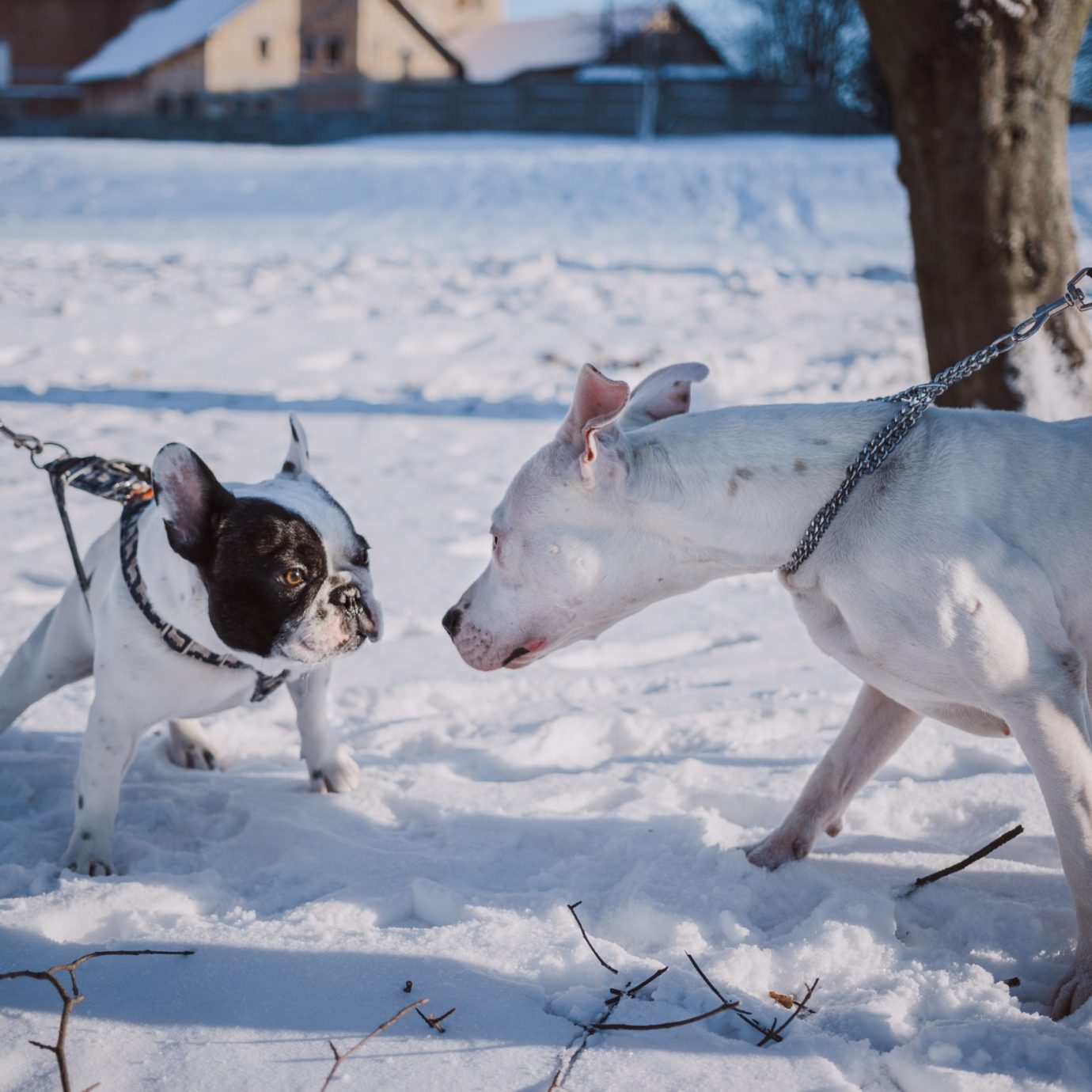
The word negative is to subtract or take something away. Reinforcers are anything that increases specific behavior.
It means the unpleasant event goes away after they do a specific behavior. Some dog trainers use choke collars. Some trainers say that if the dog is pulling on the leash, he will stop pulling to make the pain of the choke collar stop. All he has to do is top pulling, and the pain goes away.
Is this true? Should you use negative reinforcers to train your Pug dog?
Let’s reexamine the choke collar. Look at this image. It looks like the dogs have been pulling on the choke collars for some time.
In theory, because of the degree of pain around a dog’s neck, it would seem a dog would learn not to pull. When he stops pulling, the pain goes away.
However, when your Pug sees a squirrel or another dog walks by, he will not feel the pain as he is pulling. The motivation to pull is greater than the pain.
Our Pug dogs may not be aware of the pain due to the excitement of seeing the squirrel.
A brachycephalic dog may damage his windpipe before he realizes the pain that he is feeling. You must take extra care with our Pug’s health when you are working to train your Pug.
Do you think the next time your dog sees another dog or a squirrel, he’s going to remember the pain? Do you think he will stop pulling on his leash? Highly unlikely. Choke collars are not a good way to train your Pug.
Pugs are Highly Emotional
Some dog trainers don’t take into account are that dogs are emotional creatures.
Getting to that dog has a higher emotion than the pain occurring around his neck. He does not notice the pain. This is not how you train your Pug.
What about when a big dog walks by during your afternoon walk with your Pugs? You may ask your Pug dog, “Heel. Come.” Your Pug has no emotional response with those words.
Going after a large dog is going to have a significant emotional response. If a large dog amps up a Pug dog, an untrained Pug dog doesn’t notice his owner saying “heel.” Also, he doesn’t notice the pronged collar digging into their neck. Again, pronged collars are not a good way to train your Pug.
What is going to have a more significant emotional response to get your dog to pay attention to you and not the big dog? In other words, how do you train your Pug so he pays attention to you?
Become a Treat Dispenser
Treats! When a large dog walks by, you want to turn into a treat dispenser.
Your dog’s eyes may cut back and forth between the large dog and the treats. But generally, their feet stay next to their owner with the treats.
I have tried this myself, and it works. It’s a great way to train your Pug.
It’s like my Pugs are thinking, “Hey look, here comes a Labrador Retriever our way. When big dogs come around, we get lots of treats.” Well, it’s probably not like that really; just the story I like to make up in my head. In any event, it does keep them close to my side, not pulling on their leashes.
Can you and I phase out the treats when a big dog walks by? Yes. In everything I have taught them, I have been able to phase out treats. I have replaced those treats with praise and attention.
What’s the best behavior modification method to train your Pugs?
And the Winner Is … Positive Reinforcement!!
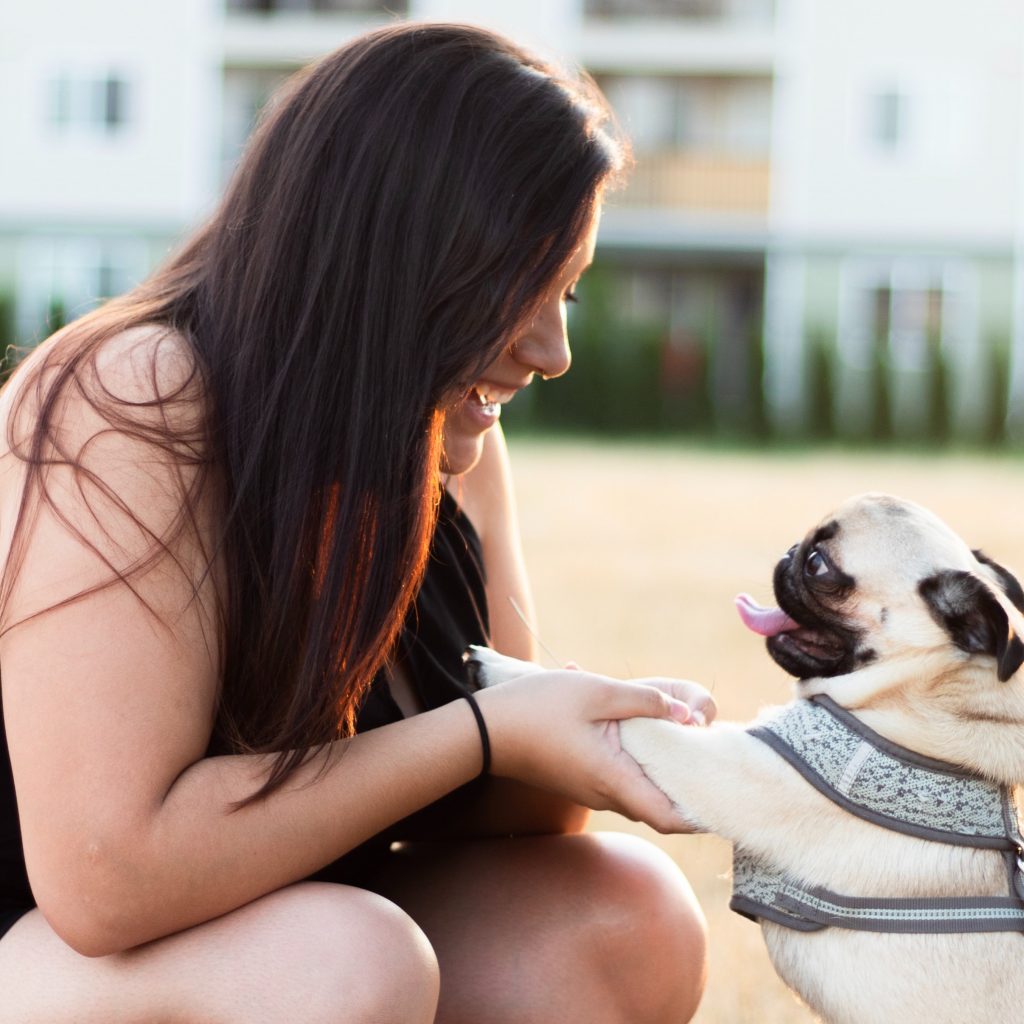
Positive reinforcement great because your Pug dog gets treats and lots of praise! Also, it is the most effective method to train your Pug.
They get treats! You see positive results! Win-win!
Positive reinforcement creates a stronger bond between you and your Pug dogs. They feel proud when they learn a new trick! It’s not proven scientifically, but I’ve seen it in their eyes!
There are still people who believe that it is not a good idea to train with treats. They think your dog will only perform if the cookies are in hand.
I have never had a problem phasing out food rewards with Mimi and Lulu. And believe me, they are big chowhounds. When I phase out the treats correctly, they continue to show the requested behavior.
Phasing Out Food Rewards
Using food rewards is a great when to train your Pug. However, we need to phase them out. When we do, we’re still going to reward our Pugs.
We don’t want our Pug dogs to turn into treat greedy, little blimps. And we don’t want to spend the rest of their lives bending over to give them a treat every time they do a trained trick.
You and I need to replace the treats with something else they desire. That replacement is praise, a pet, and/or spend a little time playing with them.
Start phasing out the treats when your Pug has generalized the behavior. That means he completes the behavior in different locations and different circumstances.
This includes the collar on, off, inside, outside, on a walk, etc. When he is doing so about 90% of the time, start phasing out the treats.
I find with the sit trick; Pug dogs learn this quickly and sit 100% of the time when asked.
If you’re using high-value treats to train your Pug, switch to kibble. High-value treats are expensive, soft treats, or any kind of meat. You want to mix it up in the beginning; half high value treats and half kibble.
Move the treat from the hand you usually give the treat from, to the other hand. Then hold it behind your back.
Have him maintain the sit for longer and longer periods before giving the treat.
Amp up your verbal praise when you give the treat. Start to replace your food reward with verbal praise and a big pet. Praise is a great way to train your Pug.
If your Pug dog has a favorite toy or game, replace the treat with a toy or a game of fetch.
Intermittent Reinforcement
Make the treat rewards unpredictable.
Intermittent reinforcement is when the rewards are unpredictable. This will increase your dog’s attention and performance.
Decrease giving treats over a few days until your Pug dog sits whenever asked.
Occasionally, give treats for sit to mix it up, but use verbal praise and pets 99% of the time. Your Pug the star of the show, and he will think you are too with those random yummy treats.
Think about casinos. Why do people keep putting so much money into those slot machines when they lose more time than win? It may feel to the person play the slots that they are winning here and there, and the big win is just around the corner!
Slot machines at the casino don’t randomly give out money. These are all programmed to give out a small cash reward on a schedule. People get hooked because of the timing of the little rewards and jackpots.
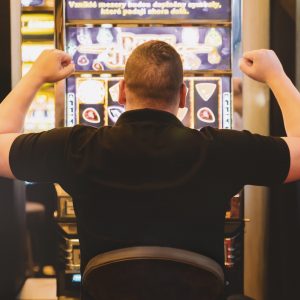
The customers get rewarded enough to keep coming back, but not too much, so the casino loses money.
Treating our Pug dogs like Casino slot machine patrons may feel wrong. But we are not “treat greedy” Pug owners trying to save all the treats for ourselves. You simply want to train your Pug to stay at a healthy weight and not spend the rest of your life dispensing treats.
Conclusion
There are four basic types of behavior modification.
Some of these behavior modification interventions harm your dog physically or emotionally. We want to be sure to avoid those. These are Positive Punishment and Negative Reinforcers. These interventions hurt and scare our Pugs.
Negative punishment can be useful.
Negative means remove something, and punishment means to decrease a behavior. Negative punishment works best when paired with Positive Reinforcement.
With negative punishment, we may turn our back on our dog who is jumping on us. We want to tell our Pugs what we would like to see instead of the “jumping on us” behavior. This is why we add Positive Reinforcement.
Positive reinforcement is the winning intervention. Give your Pug something good (yummy chicken), and Pug dogs learn to do the behavior we are looking for more often. It could be a sit, high five, or whatever fun trick you would like to teach. This is the fastest way to train your Pug.
Some people get too hung up that the dog will never perform without the treats. Not true. Our Pugs are emotional creatures. When we have a positive relationship with him, he wants to please us. We can replace those treats with verbal praise and other rewards.
Positive reinforcement is a win/win for both you and your Pug. Not only is Positive reinforcement the kindest method of them all, but it is also the most effective.
Now grab some treats and decide what trick you’re going to start training your Pug dog today.

